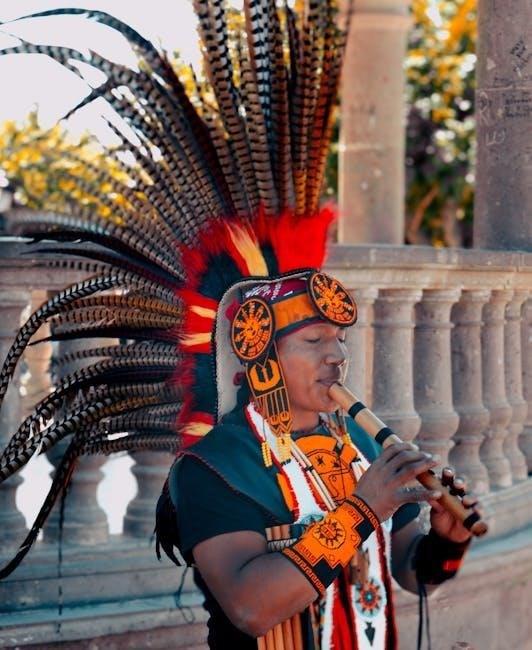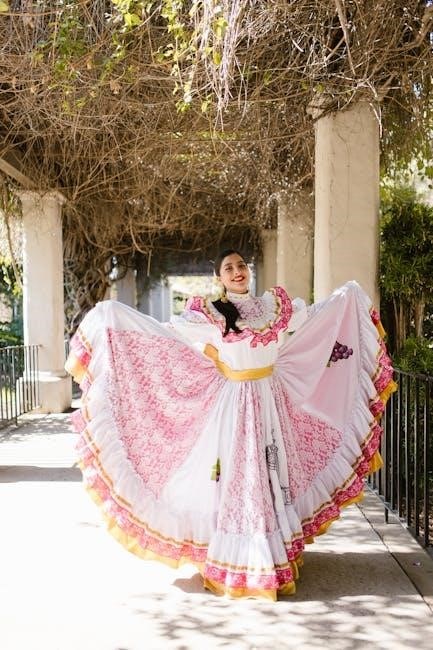Hispanic Heritage Month, celebrated September 15–October 15, honors the rich cultural contributions of Hispanic and Latino Americans. Worksheets are essential tools for educating students about this vibrant heritage.
1.1 History and Significance of Hispanic Heritage Month
Hispanic Heritage Month, observed from September 15 to October 15, celebrates the cultural richness and contributions of Hispanic and Latino Americans. Originating as Hispanic Heritage Week in 1968, it expanded to a month in 1988. The date aligns with Independence Days in several Latin American countries, symbolizing freedom and pride. Worksheets for this month are designed to educate students about its history, fostering cultural awareness and appreciation. By integrating these resources, educators highlight the enduring impact of Hispanic heritage on American society, making learning interactive and meaningful. This observance is a tribute to the diversity that strengthens our nation.
1.2 Purpose of Celebrating Hispanic Heritage Month
The purpose of Hispanic Heritage Month is to recognize the profound contributions of Hispanic and Latino Americans to U.S. history, culture, and society. It aims to promote cultural awareness, celebrate traditions, and honor achievements. By fostering understanding and appreciation, the month bridges communities and highlights shared values. Educational resources, such as worksheets, play a vital role in engaging students with the richness of Hispanic heritage. These tools help learners explore history, language, and traditions, making the celebration both educational and meaningful. Through this observance, we strengthen diversity and inclusivity, ensuring future generations embrace this vibrant cultural legacy.

Importance of Educational Resources for Hispanic Heritage Month
Educational resources, such as PDF worksheets, are vital for teaching students about Hispanic culture, traditions, and contributions. They engage learners and promote cultural awareness and understanding effectively.
2.1 Role of Worksheets in Education
Worksheets play a crucial role in education by providing structured learning experiences. They help students engage with content in an organized and interactive manner. For Hispanic Heritage Month, worksheets offer a versatile tool to explore history, culture, and language. They cater to different learning styles, making complex topics more accessible. Worksheets also encourage active participation, fostering deeper understanding and retention; Additionally, they serve as valuable resources for assessing student progress and reinforcing key concepts. By incorporating cultural elements, worksheets make learning about Hispanic heritage both educational and engaging for students of all ages. They are essential for creating meaningful and impactful lessons.

2.2 Benefits of Using PDF Worksheets for Learning
PDF worksheets offer numerous benefits for learning, particularly during Hispanic Heritage Month. They are easily accessible, printable, and can be shared digitally, making them convenient for both teachers and students. PDFs maintain consistent formatting, ensuring clarity and readability. They are also cost-effective and environmentally friendly, reducing the need for physical materials. Additionally, PDF worksheets can be easily updated and customized to meet specific educational needs. Their portability allows students to complete assignments anywhere, promoting flexible learning. PDF worksheets are also ideal for archiving and revisiting material, supporting long-term retention of cultural and educational content.
Types of Hispanic Heritage Month Worksheets
Hispanic Heritage Month worksheets vary widely, covering cultural awareness, language learning, history, geography, and traditional celebrations. They cater to diverse educational needs and age groups effectively.

3.1 Cultural Awareness Worksheets
Cultural awareness worksheets are designed to educate students about the traditions, history, and contributions of Hispanic communities. These worksheets often include activities that highlight important cultural symbols, festivals, and values. They may feature matching games, fill-in-the-blank exercises, and short essays to encourage students to reflect on the significance of cultural heritage. By exploring these topics, students gain a deeper appreciation for the diversity and richness of Hispanic cultures. These resources are particularly useful for teachers seeking to incorporate cultural education into their lesson plans during Hispanic Heritage Month. They promote inclusivity and understanding in the classroom.
3.2 Language Learning Worksheets
Language learning worksheets are valuable tools for teaching Spanish and other Hispanic languages during Hispanic Heritage Month. These worksheets often include vocabulary lists, verb conjugations, and sentence structure exercises. They are designed to help students build foundational language skills while exploring cultural contexts. Activities may focus on common phrases, traditional dialects, and regional expressions; By integrating language learning with cultural awareness, these worksheets provide a comprehensive educational experience. They are ideal for students of all proficiency levels, from beginners to advanced learners, and are widely available in PDF formats for easy accessibility and distribution in the classroom.
3.3 History and Geography Worksheets
History and geography worksheets are essential for exploring the rich heritage of Hispanic countries. These worksheets often include maps, timelines, and factual questions about key historical events and cultural movements. Students can learn about the history of Spanish-speaking nations, their independence movements, and the contributions of notable figures. Geography-focused worksheets highlight the diverse landscapes, capitals, and significant landmarks of Hispanic countries. These resources also emphasize the cultural exchange between Spain, Latin America, and the United States. By combining historical facts with geographic insights, these worksheets provide a comprehensive understanding of the Hispanic world and its global influence. They are ideal for integrating social studies with cultural education during Hispanic Heritage Month.
Popular Hispanic Heritage Month Worksheets
Popular Hispanic Heritage Month worksheets include a variety of educational activities that celebrate cultural richness and diversity, providing engaging learning experiences for students of all ages.
4.1 Math Worksheets with a Hispanic Cultural Twist
Math worksheets with a Hispanic cultural twist blend traditional math problems with elements of Hispanic heritage, making learning engaging and culturally relevant. These worksheets often feature themes like counting traditional foods, measuring ingredients for recipes, or solving problems related to cultural celebrations. They incorporate vibrant visuals and authentic scenarios, helping students connect math to real-life experiences. By aligning with educational standards, these resources make learning fun while fostering cultural appreciation. Teachers and students alike find these worksheets valuable for their unique blend of education and cultural enrichment. They are widely available in PDF formats online.
4.2 Language Arts Worksheets Focused on Hispanic Literature
Language arts worksheets centered on Hispanic literature are designed to deepen students’ understanding of the rich literary contributions of Hispanic authors. These worksheets often include passages from renowned writers like Gabriel García Márquez and Isabel Allende, followed by comprehension questions and analysis prompts. They also focus on vocabulary building, cultural themes, and stylistic elements unique to Hispanic literature. By engaging with these texts, students gain insight into the traditions and perspectives of Hispanic cultures. Many of these worksheets are available as downloadable PDFs, making them accessible for classroom and remote learning environments.
4.3 Science and Social Studies Worksheets

Science and social studies worksheets for Hispanic Heritage Month offer engaging ways to explore the intersection of culture and academics. These worksheets often feature lessons on environmental science in Latin America, historical figures in Hispanic science, and geography-focused activities. For social studies, they might include timelines of key events, biographies of influential leaders, and map exercises highlighting Spanish- and Portuguese-speaking countries. Interactive elements like crossword puzzles and matching games make learning fun. Designed for various age groups, these PDF resources blend cultural education with curriculum-aligned content, ensuring both enjoyment and educational value during Hispanic Heritage Month.

Where to Find Hispanic Heritage Month Worksheets
Discover Hispanic Heritage Month worksheets through educational websites, online marketplaces, and teacher resource platforms. Popular options include Teachers Pay Teachers, Education.com, and Scribd for free or paid PDFs.
5.1 Free PDF Resources Online
Free PDF resources for Hispanic Heritage Month worksheets are widely available online, offering a cost-effective way to enhance learning. Websites like Teachers Pay Teachers, Education.com, and Scribd provide a variety of downloadable worksheets. These resources often include cultural trivia, language exercises, and historical facts. Many are designed for different grade levels, ensuring accessibility for students of all ages. Additionally, platforms like Google Classroom and Pinterest feature shared PDFs from educators, making it easy to find and print materials. These free resources are a great starting point for educators and parents looking to celebrate Hispanic Heritage Month in an engaging and educational way.
5.2 Educational Websites Offering Worksheets
Educational websites like ReadWriteThink, ABCmouse, and Super Teacher Worksheets provide a wide range of Hispanic Heritage Month worksheets in PDF format. These platforms cater to diverse learning needs, offering activities that align with curriculum standards. From language arts to social studies, the worksheets are designed to engage students while fostering cultural understanding. Many sites allow teachers to filter by grade level, ensuring age-appropriate content. These resources are invaluable for educators seeking structured, high-quality materials to integrate Hispanic Heritage Month into their lesson plans effectively.
5.3 Teachers’ Resources and Lesson Plans
Teachers can access comprehensive resources and lesson plans tailored for Hispanic Heritage Month through dedicated educational platforms. These resources often include PDF worksheets, activity guides, and unit plans that align with curriculum standards. Many websites offer customizable materials, allowing educators to adapt content to their classroom needs. Additionally, lesson plans frequently incorporate multimedia elements, such as videos and interactive activities, to enhance student engagement. These resources not only provide structured learning opportunities but also help teachers integrate cultural awareness and historical context seamlessly into their instruction.
Creating Your Own Hispanic Heritage Month Worksheets
Designing custom worksheets allows educators to tailor content to specific learning objectives and student needs. Incorporating cultural elements and interactive activities enhances engagement and understanding.
6.1 Tips for Designing Engaging Worksheets
Engage students with visually appealing designs and culturally relevant content. Use vibrant colors, images, and authentic cultural elements to capture interest. Incorporate interactive activities like puzzles, quizzes, or matching games to promote active learning. Ensure instructions are clear and concise, avoiding clutter. Differentiate difficulty levels to cater to diverse learners. Balance educational content with fun, fostering a deeper connection to Hispanic heritage. Align activities with learning objectives while encouraging creativity and critical thinking. This approach ensures worksheets are both educational and enjoyable, making them effective tools for celebrating Hispanic Heritage Month.
6.2 Incorporating Authentic Cultural Elements
Incorporate authentic cultural elements to make worksheets meaningful and engaging. Include traditional symbols, such as flags, landmarks, or cultural icons. Use accurate representations of Hispanic traditions, music, and art. Highlight notable historical figures and their contributions. Ensure language accuracy by using correct Spanish terms and phrases. Reflect the diversity of Hispanic cultures by including elements from various countries. Add authentic proverbs, sayings, or folklore to enrich content. Use images and references that resonate with students’ backgrounds, fostering a sense of connection and pride. Authenticity enhances learning and ensures cultural respect and appreciation.
6.3 Aligning Worksheets with Curriculum Standards
Aligning Hispanic Heritage Month worksheets with curriculum standards ensures they support educational goals. Worksheets should complement language arts, social studies, and other subjects. Use state and national standards as a guide to ensure relevance. Incorporate skills like critical thinking and cultural awareness. Design activities that meet specific learning objectives, such as vocabulary building or historical analysis. Ensure content is age-appropriate and challenging. Aligning with standards guarantees worksheets are effective and integrate seamlessly into lesson plans. This approach enhances learning outcomes and ensures students gain valuable knowledge about Hispanic heritage while meeting academic requirements. Adapt worksheets to fit diverse curriculum needs.

Cultural Activities for Hispanic Heritage Month
Cultural activities for Hispanic Heritage Month include traditional crafts, music, dance, and food celebrations. These activities promote cultural appreciation and educational experiences, enriching community engagement and understanding.
7.1 Traditional Crafts and Art Projects
Traditional crafts and art projects are a vibrant way to celebrate Hispanic Heritage Month. Activities like making piñatas, pottery, and traditional textiles allow students to explore cultural traditions. These hands-on projects foster creativity and provide a deeper connection to Hispanic customs. Many worksheets include templates and guides for these crafts, making them accessible for all skill levels. By engaging in these art projects, students learn about the cultural significance behind each craft, enriching their understanding of Hispanic heritage. These activities also align with educational goals, encouraging cultural appreciation and creativity while catering to diverse age groups and learning styles.
7.2 Music and Dance Activities
Music and dance are integral to Hispanic culture, making them a vibrant part of celebrations. Worksheets often include guides for learning traditional dances like salsa, merengue, and bachata. Activities may involve creating instruments, such as maracas, or exploring the history of Latin music genres. Students can also engage in rhythm exercises or lyric writing. These activities foster cultural appreciation and physical expression. By integrating music and dance into learning, educators create engaging and memorable experiences that highlight the richness of Hispanic heritage while promoting creativity and movement. These activities are ideal for all age groups, enhancing both cultural and physical education.
7.3 Food and Cooking Traditions
Hispanic food and cooking traditions are a cornerstone of cultural identity. Worksheets often feature recipes, cooking instructions, and fun facts about iconic dishes like tacos, empanadas, and arroz con pollo. Activities include matching games linking ingredients to dishes, crossword puzzles with food-related vocabulary, and coloring pages of traditional meals. Students learn about the historical and regional significance of these dishes while developing culinary skills. These worksheets make learning interactive and delicious, allowing students to explore Hispanic culture through taste and tradition. Cooking activities also foster teamwork and cultural appreciation, making them a flavorful addition to celebrations.

Age-Specific Hispanic Heritage Month Worksheets
Worksheets are tailored for different age groups, ensuring content aligns with developmental stages, from simple cultural activities for young students to complex analyses for older learners.
8.1 Worksheets for Elementary School Students
Worksheets designed for elementary students focus on introductory concepts, blending fun with learning. Activities include coloring pages, matching games, and simple puzzles that introduce Hispanic cultures. These resources often feature basic Spanish vocabulary, traditional celebrations, and famous Hispanic figures. Interactive exercises help young learners develop foundational skills while exploring cultural heritage. Teachers can use these tools to align with curriculum standards, ensuring educational value. Many worksheets are available as free PDF downloads, making them accessible for classrooms and home use. They provide an engaging way to spark curiosity and appreciation for Hispanic traditions among young students.
- Coloring pages of cultural symbols
- Basic Spanish vocabulary exercises
- Simple history and traditions

8.2 Worksheets for Middle and High School Students
Worksheets for middle and high school students are designed to deepen understanding of Hispanic heritage through more complex activities. These resources often include essay prompts, historical case studies, and cultural analyses. Language arts exercises focus on advanced Spanish vocabulary and grammar, while social studies worksheets explore the contributions of Hispanic figures. Geography-focused worksheets highlight key Latin American countries and their cultures. Critical thinking is encouraged through debates and research projects. These PDFs align with curriculum standards, providing engaging and challenging content for older students to explore Hispanic traditions, history, and modern influences.
- Advanced vocabulary and grammar exercises
- Historical and cultural case studies
- Research and critical thinking projects
8.3 Worksheets for College and Adult Learners
Worksheets for college and adult learners focus on advanced topics, fostering deeper cultural understanding and academic rigor. These PDF resources include in-depth language exercises, essay prompts on Hispanic identity, and historical analyses. Activities often involve discussions, research projects, and case studies on social and political issues impacting Hispanic communities. Critical thinking is emphasized through comparative analyses of literature, art, and history. These worksheets also incorporate professional development, such as Spanish for business or academic purposes. They align with higher education standards, providing engaging and intellectually stimulating content for mature learners.
- Advanced language and cultural analysis
- Research and discussion-based activities
- Professional and academic applications

Incorporating Technology into Hispanic Heritage Month Learning
Incorporating technology enhances engagement with Hispanic Heritage Month learning through digital tools and interactive PDFs. Educational apps and online platforms offer customizable worksheets, fostering immersive experiences.
- Digital tools for interactive learning
- Customizable PDF worksheets online
- Educational apps for enhanced engagement
9.1 Digital Worksheets and Interactive PDFs
Digital worksheets and interactive PDFs revolutionize Hispanic Heritage Month learning by offering engaging, adaptable resources. These tools often feature clickable activities, quizzes, and multimedia elements, enhancing student interaction. Teachers can easily customize content to suit various learning levels, ensuring accessibility for all students. Interactive PDFs also allow real-time feedback, helping track progress and understanding. Additionally, digital formats reduce paper waste and are easily shareable across devices, making them a convenient option for modern classrooms. They blend tradition with innovation, fostering a deeper connection to Hispanic culture and language through dynamic, tech-driven experiences.
9.2 Online Tools for Creating and Sharing Worksheets
Online tools like Google Docs, Canva, and Adobe Acrobat enable educators to create and share Hispanic Heritage Month worksheets effortlessly. These platforms offer customizable templates, design flexibility, and collaboration features. Teachers can craft interactive PDFs, incorporate images, and add links to enhance learning. Sharing options allow seamless distribution via email, classroom platforms, or educational websites. These tools also support co-creation with colleagues, ensuring diverse and engaging content. By leveraging these resources, educators can efficiently develop and disseminate high-quality worksheets, fostering a dynamic and inclusive learning environment for students celebrating Hispanic Heritage Month.
9.3 Apps for Enhancing Learning Activities
Educational apps like Duolingo, Kahoot!, and Quizlet enhance learning activities for Hispanic Heritage Month by offering interactive language lessons and cultural trivia. Apps such as Flipgrid and Padlet facilitate collaborative discussions and creative projects. PDF annotation tools like Kami and DocHub enable students to interact with worksheets digitally, highlighting and annotating content. Additionally, apps like Google Classroom and Seesaw streamline the sharing and grading of PDF worksheets. These tools foster engagement, collaboration, and personalized learning, making Hispanic Heritage Month education more dynamic and accessible for students of all ages.
Assessing the Effectiveness of Worksheets
Evaluate student engagement and learning outcomes through completed worksheets, analyzing progress and understanding. Use feedback from educators and students to refine and improve future educational materials.
10.1 Measuring Student Engagement
Measuring student engagement with Hispanic Heritage Month worksheets involves observing participation, interest, and effort. Track time spent, quality of work, and enthusiasm. Use surveys and teacher observations to assess involvement and interest compared to other activities. High engagement is indicated by active participation, thoughtful responses, and eagerness to learn about Hispanic culture. Feedback from students and educators helps refine the worksheets to better capture students’ attention and foster meaningful learning experiences. This ensures the materials are effective in promoting cultural awareness and academic engagement.
10.2 Evaluating Learning Outcomes
Evaluating learning outcomes from Hispanic Heritage Month worksheets involves assessing knowledge retention, critical thinking, and cultural understanding. Use quizzes, class discussions, and project completion to measure comprehension. Align worksheets with curriculum standards to ensure alignment with learning goals. Track progress through pre- and post-assessments to identify improvements. Use rubrics to evaluate the quality of work and understanding of cultural concepts. Feedback from assignments helps determine if students have met learning objectives, ensuring the worksheets effectively promote academic and cultural growth during Hispanic Heritage Month celebrations.
10.3 Receiving Feedback from Students and Teachers
Receiving feedback from students and teachers is crucial for refining Hispanic Heritage Month worksheets. Surveys, direct input, and discussions provide insights into effectiveness and engagement. Teachers often highlight alignment with curriculum goals and cultural relevance, while students share their experiences with content clarity and interest. This dual perspective ensures improvements are balanced and impactful. Positive feedback reinforces successful elements, while constructive criticism guides enhancements. By listening to both groups, educators can adapt worksheets to better meet learning needs and foster deeper cultural appreciation, ultimately enriching the educational experience for all participants during Hispanic Heritage Month.
